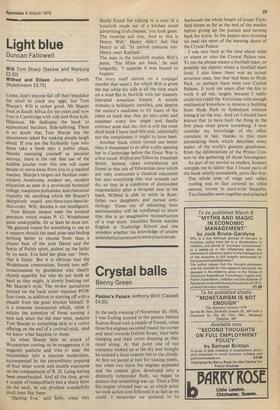Crystal balls
Benny Green
Paxton's Palace Anthony Bird (Cassell £4.50) In the early evening of November 30, 1936, I was fooling around in the gutters behind Euston Road with a couple of friends, when three fire engines swooped round the corner and sped towards Oxford Street, their bells clanging and their crews dressing as they raced along. At that point one of our company looked up at the sky and thought he noticed a faint roseate tint to the clouds. At first we jeered at him for waxing poetic, but when two more fire engines appeared and the roseate glow developed into a distinctly tubercular flush, we began to deduce that something was up. Then a fifth fire engine whizzed past us, at which point we took action and followed it as fast as we could. I remember we sprinted in its backwash the whole length of Great Titchfield Street as far as the end of the market before giving up the pursuit and turning back for home. In the papers next morning we read the news of the burning down of the Crystal Palace.
I was very hazy at the time about what or where or who the Crystal Palace was. To me the phrase meant a football team, or possibly the district where a football team lived. I also knew there was an actual structure once, but that had been in Hyde Park, so perhaps there were two Crystal Palaces. It took me years after the fire to work it all out, largely because I really could not credit the Victorians with enough mechanical knowhow to remove a building from Hyde Park to Sydenham without losing it on the way. And yet I should have known that to have built the thing in the first place must prove something. I now consider my knowledge of the affair complete at last, thanks to this most painstaking book which describes every aspect of the world's greatest glasshouse, from the deliberations of the Prince Consort to the gathering of those fire-engines.
As part of my service to readers, honesty compels me to admit that I found parts of the book utterly unreadable, parts like this: The whole area of ridge and valley roofing was in fact covered by white canvas, woven in yard-wide breadths.
Two breadths sewn together and attached to two adjacent ridge beams hung down in the intervening valley so that the seam, suitably pierced with eyeletted drain holes, ran a few inches above the Paxton gutter. Two paragraphs of that kind of thing and my mind metamorphoses into a kind of high-grade soup; even so, for once I am able to endorse such technological gobbledegook with a clear conscience, because if we are to have a book about an engineering miracle like the Crystal Palace, then we should have everything in it, including the technicalities. There are sketches of the elevation of the balusters, of a longitudinal section of the roof, of the elevation of the lower part of the gallery front, and various other intimidating architectural squiggles. What puts the whole business in perspective is the fact, which the book most justifiably keeps thrusting under the reader's nose, that the entire enterprise took only a few months.
It is this phenomenal speed of execution which lends the narrative an extra dimension. Instead of just arranging the story, Bird tells it by counterpointing the likely imbecilities with computers and consultants if the same business were to happen today. He is very much a pro-Victorian, and very much an admirer of self-made men like Paxton, who began as a gardener's boy and ended as—the creator of the Crystal Palace.
It is the remarkable Paxton who steals the whole show from under the silly nose of Barry, the noble nose of Isambard Brunel, the ubiquitous nose of the Prince Consort. Indeed, the one man who towards the end of the story, refuses to be eclipsed totally by the all-conquering Paxton is that wily old empiricist fox, the Duke of Wellington, who takes in Paxton at a glance, recognises him as a man after his own heart, and smoothes away the few remaining diplomatic difficulties. Sadly, it appears that one of the Duke's finest hours, his `Sparrowhawks, ma'am' speech, never really happened. But practically everything else did, including the sensational move to Sydenham, where the Palace gradually languished, revived a little and finally went up in smoke. I am sorry that no mention is made of Dr W. G. Grace's curious flirtation with the Palace when he went to Sydenham in a fit of pique after a row with the Gloucestershire committee and actually had the effrontery to start his own county, London CC, and I would have liked something about the Great Exhibition as a symbol of something or other. Was it G. M. Young who once pointed out the sensational progress from Chartism to the Great Exhibition, from impending revolution to architectural gaiety in a few years ? Whoever it was, the curious reader can to this very day trot off to Hyde Park and discover for himself what I found last year while televising the history of London, not far from the new Horseguard barracks. There is an ornamental gate leading to and from nowhere in particular, embossed with heraldic designs and coats of arms. It is the last vestigial proof that Paxton once passed that way.



































 Previous page
Previous page